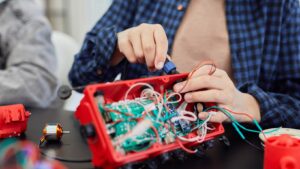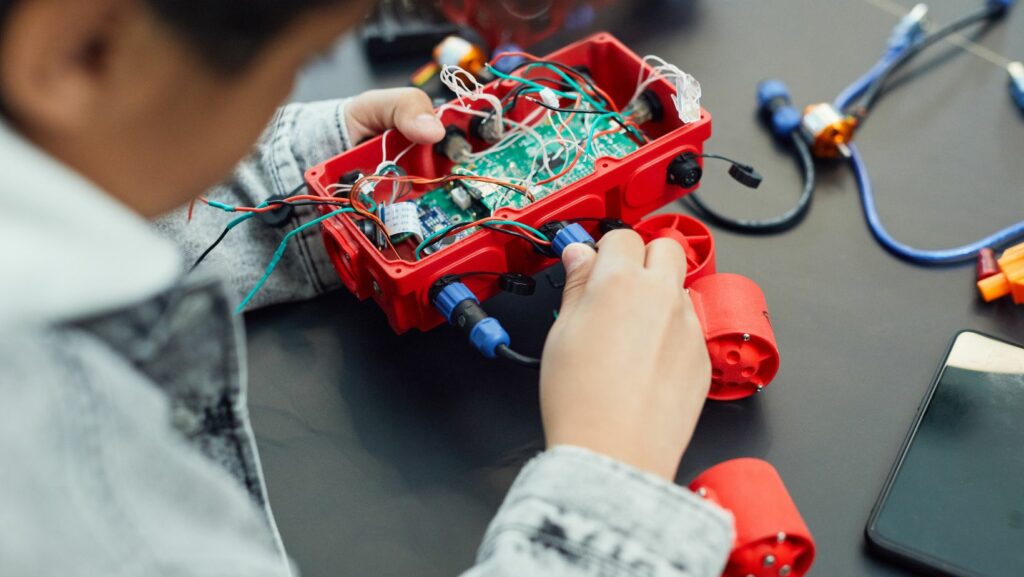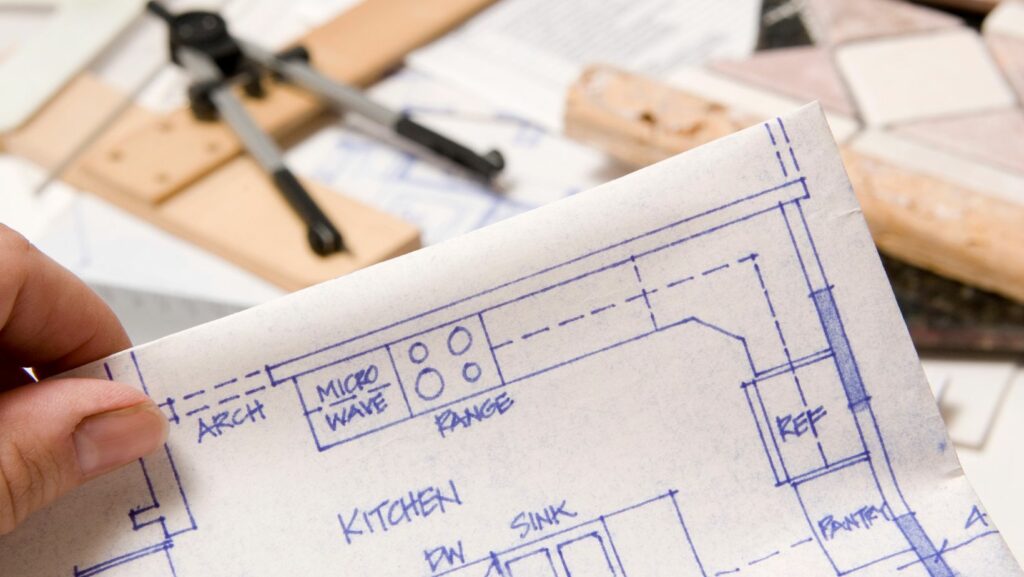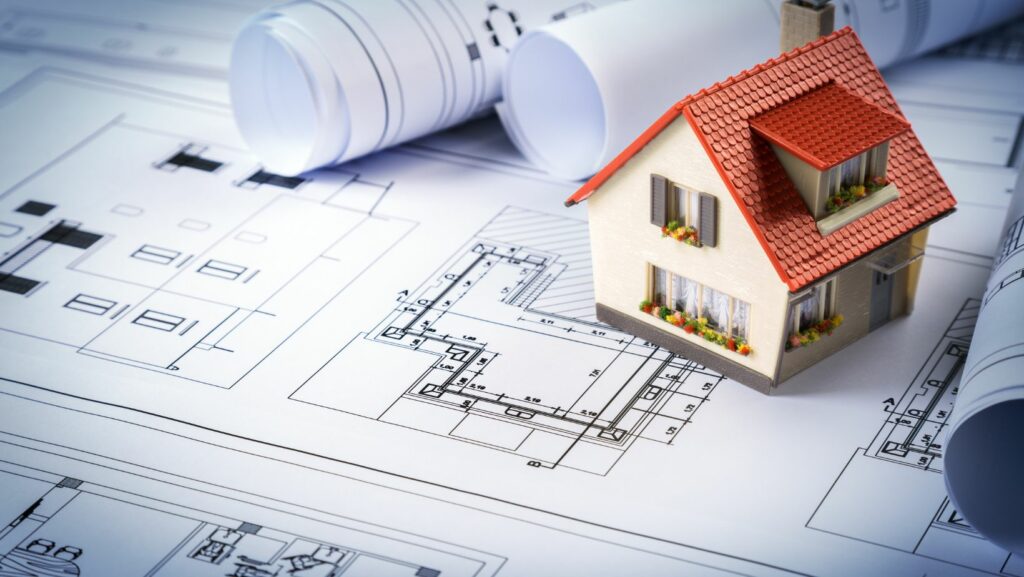DIY Electronics Projects
- DIY Electronics Projects Empower Creativity: Engaging in DIY electronics allows individuals to combine creativity with practical skills, resulting in innovative and functional devices.
- Accessible for All Skill Levels: Both beginners and experienced makers can find projects that suit their abilities, ranging from simple circuit designs to advanced robotics.
- Essential Tools and Materials: Proper tools, including soldering irons, multimeters, and basic components like resistors and microcontrollers, are crucial for success in DIY projects.
- Importance of Safety Practices: Prioritizing safety by using protective gear, working in ventilated areas, and following project instructions is vital for a secure DIY electronics experience.
- Rich Resources and Community Support: Numerous online tutorials, forums, and local workshops offer guidance and foster collaboration among electronics enthusiasts, enhancing learning opportunities.
- Project Diversity Encourages Learning: From LED circuits to Arduino-based innovations, the variety of projects available stimulates interest and deepens understanding of electronics.
 In a world driven by technology, DIY electronics projects offer a thrilling way to blend creativity with practical skills. Whether it’s building a simple LED circuit or a complex robot, these hands-on projects empower enthusiasts to explore the fascinating realm of electronics. The satisfaction of creating something functional from scratch is unmatched, and it opens doors to endless possibilities.
In a world driven by technology, DIY electronics projects offer a thrilling way to blend creativity with practical skills. Whether it’s building a simple LED circuit or a complex robot, these hands-on projects empower enthusiasts to explore the fascinating realm of electronics. The satisfaction of creating something functional from scratch is unmatched, and it opens doors to endless possibilities.
For beginners and seasoned makers alike, DIY electronics projects provide an accessible entry point into the tech world. With the right tools and a little guidance, anyone can dive in and start crafting their own gadgets. Embracing this hobby not only enhances problem-solving skills but also fosters a deeper understanding of how electronic devices work. Let’s explore some exciting DIY electronics projects that can spark innovation and inspire creativity.
Overview Of DIY Electronics Projects
DIY electronics projects encompass a wide range of activities that allow individuals to design and create electronic devices. These projects serve various purposes, from enhancing personal skills to addressing specific needs. Beginners can start with simple projects like LED blinkers or basic circuit assemblies. Experienced makers can advance to more complex systems, such as home automation or robotics.
Engaging in DIY electronics fosters creativity and practical problem-solving skills. Makers utilize various components, such as resistors, capacitors, microcontrollers, and sensors, to bring their ideas to life. A solid understanding of fundamental electronics principles aids in these endeavors, enabling individuals to troubleshoot issues and innovate.
Projects can vary significantly in scope and complexity, ranging from educational tools to fun gadgets. Popular categories for DIY electronics projects include:
- Wearable technology: Smartwatches and fitness trackers.
- Home automation: Smart lighting systems, temperature controllers.
- Robotics: Simple robots to more sophisticated autonomous devices.
- Gaming: Custom gaming consoles or retro handheld devices.
Resources for DIY electronics abound, including online tutorials, community forums, and specialized kits. Makers can access free educational materials, allowing them to expand their knowledge and skills efficiently. Networking with fellow enthusiasts through local or online groups often helps in sharing insights and troubleshooting challenges encountered during projects.
Essential Tools And Materials
Engaging in DIY electronics projects requires specific tools and materials to achieve desired results effectively. Below are essential tools and recommended components for successful project completion.
Basic Tools Needed
- Soldering Iron: Necessary for connecting electronic components, a soldering iron provides heat to melt solder and forms permanent connections.
- Wire Cutters: Important for trimming wires, wire cutters allow for clean cuts to ensure precise measurements in circuit designs.
- Multimeter: Useful for measuring voltage, current, and resistance, a multimeter aids in troubleshooting and verifying circuit functionality.
- Breadboard: Serves as a reusable platform, a breadboard simplifies the process of prototyping circuits without soldering.
- Pliers: Needed for gripping, bending, and cutting wires, pliers enhance manipulation of components in confined spaces.
- Resistors: Vital for controlling current flow, resistors come in various values and are fundamental in most electronic circuits.
- Capacitors: Useful for storing electrical energy, capacitors aid in smoothing voltage fluctuations and enhancing circuit stability.
- LEDs: Light-emitting diodes (LEDs) serve as indicators in many projects, providing visual feedback for circuit states.
- Microcontrollers: Essential for programmable projects, microcontrollers like Arduino or Raspberry Pi allow for advanced control and automation.
- Transistors: Acting as switches or amplifiers, transistors facilitate signal modulation and are key in building complex circuits.
Popular DIY Electronics Projects
Exploring popular DIY electronics projects showcases the creativity and technical skills involved in this hobby. These projects range from simple circuits to advanced systems, catering to individuals at different skill levels.
Simple LED Circuit
Creating a simple LED circuit serves as an excellent introduction to electronics. This project involves connecting an LED to a power source using a resistor to limit the current and prevent damage. Makers can design variations by incorporating multiple LEDs or adding a switch to control the circuit. Simple LED circuits provide fundamental experience in understanding voltage, current, and circuit design.
Arduino-Based Projects
Arduino-based projects offer endless possibilities for customization and innovation. Arduino boards enable users to create interactive devices using sensors, motors, and displays. Common projects include automated plant watering systems, motion-detecting alarms, and LED light shows. These projects require basic programming knowledge, as users write code to control hardware components. Arduino’s versatility makes it a popular choice among beginners and advanced makers alike, enhancing their skills in coding and electronics integration.
Safety Tips For DIY Electronics
Engaging in DIY electronics projects requires awareness of safety practices. Following specific safety tips ensures a secure and enjoyable experience.
- Wear Protective Gear: Using safety goggles protects eyes from flying debris during soldering. Wearing gloves minimizes the risk of electric shock or injury from sharp components.
- Work in a Well-Ventilated Area: Ensuring proper ventilation reduces inhalation of fumes generated from soldering and other materials. Avoiding confined spaces promotes a healthier environment.
- Handle Electronics with Care: Treating all components delicately prevents damage. Remembering that static electricity can harm sensitive parts, grounding oneself before handling sensitive electronic components is crucial.

- Disconnect Power Sources: Unplugging devices before assembly or repair prevents accidental shocks. Confirming that all power sources are securely disconnected before starting work is essential.
- Use Quality Tools: Utilizing quality tools reduces the chance of accidents. Choosing tools that are appropriate for the project ensures better precision and safety during use.
- Avoid Overloading Circuits: Understanding circuit limits prevents overheating and potential fires. Calculating voltage and current according to specifications avoids damage to components.
- Keep Workspaces Organized: Maintaining a clean and organized workspace reduces tripping hazards and misplacing components. A tidy area fosters focus and minimizes distractions during projects.
- Educate on First Aid: Knowing basic first aid for electrical burns or cuts prepares one for emergencies. Familiarizing oneself with local emergency contacts ensures prompt assistance if needed.
- Follow Project Instructions: Adhering to guidelines and specifications for each project enhances safety and success. Reading through all instructions thoroughly before starting minimizes errors.
Implementing these safety tips enhances the overall DIY electronics experience. By prioritizing safety, individuals can engage in creative projects confidently and securely.
Resources And Communities
Engagement in DIY electronics projects benefits from a variety of resources and communities. Online platforms provide tutorials, guides, and forums to facilitate learning and collaboration among makers.
Online Tutorials and Websites
- Instructables – Offers step-by-step guides for a multitude of projects, catering to all skill levels.
- Adafruit – Features tutorials focused on electronics components, microcontrollers, and wearable technology.
- SparkFun – Provides extensive resources, including project ideas and component explanations.
Community Forums
- EEVblog Forum – A hub for electronics enthusiasts, allowing discussions on projects, troubleshooting, and advice.
- Arduino Forum – Focuses on Arduino-related projects, offering support and project-sharing among users.
- Hackaday.io – Encourages sharing of completed projects and ideas, fostering collaboration within the maker community.
Social Media and Online Groups
- Facebook Groups – Various groups focus on DIY electronics, project-sharing, and skill development.
- Reddit – Subreddits like r/DIY and r/electronics provide a space for discussions and project feedback.
- Discord Servers – Many communities host servers for real-time collaboration and project support.
- Maker Faires – Events that showcase DIY projects where individuals can meet fellow enthusiasts and learn new skills.
- Hackerspaces – Local facilities provide access to tools and resources, along with opportunities for collaboration and workshops.
- Community Colleges – Many offer courses in electronics, providing hands-on experience and access to instructors.
Utilizing these resources and engaging with communities enhances knowledge, fosters creativity, and supports successful execution of DIY electronics projects.
Creativity and Skill Development
DIY electronics projects offer an incredible opportunity for creativity and skill development. Whether one is a beginner or an experienced maker there’s always something new to learn and create. The satisfaction of building functional devices from scratch can be immensely rewarding.
By leveraging available resources and engaging with communities, individuals can enhance their knowledge and tackle increasingly complex projects. Prioritizing safety while experimenting ensures a positive experience. Embracing the world of DIY electronics not only cultivates technical skills but also sparks innovation and collaboration among enthusiasts. So grab some tools and start creating; the possibilities are endless.
“



